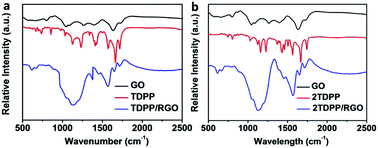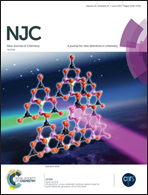Diketopyrrolopyrrole derivative functionalized graphene for high performance visible-light photodetectors
Abstract
Although graphene has unique electronic and optical properties, its application in photodetectors is still limited due to its low optical absorption. In this work, graphene was first functionalized with diketopyrrolopyrrole derivatives (TDPP, TTDPP) to enhance the light absorption of hybrid systems. The morphology, optical absorption and photoluminescence properties were investigated in order to elucidate the interaction between the graphene and diketopyrrolopyrrole derivatives. The time-resolved fluorescence data verified the occurrence of the interface charge transfer between TDPP or TTDPP molecules and graphene in the hybrids. Visible-light photodetectors based on TTDPP/RGO hybrids exhibit a maximum photoresponsivity of 34.2 A W−1 and the on/off ratio is 282. We conclude that the high photoresponse is consistent with the efficient charge-transfer process occurring at the interface between TTDPP and graphene. 2D-graphene here serves not only as a superior supporting matrix for anchoring the sensitizer molecules but also as an excellent electron mediator to adjust electron transfer. Our research paves the way to build high-performance optoelectronic devices based on 2D graphene and organic compounds.



 Please wait while we load your content...
Please wait while we load your content...